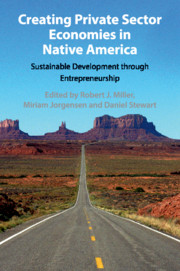 Creating Private Sector Economies in Native America
Creating Private Sector Economies in Native America Book contents
- Creating Private Sector Economies in Native America
- Creating Private Sector Economies in Native America
- Copyright page
- Contents
- Figures
- Tables
- Contributors
- Introduction
- Part I The Setting
- 1 Private Sector Economic Development in Indian Country
- 2 Opportunities to Diversify: Reservation Workplaces and Job Numbers Compared to Nearby County Areas
- Part II Policy Barriers and Policy Needs
- Part III Learning from Business Scholars
- Part IV From Learning to Doing: Examples of Entrepreneurship in Indian Country
- Index
1 - Private Sector Economic Development in Indian Country
from Part I - The Setting
Published online by Cambridge University Press: 15 October 2019
- Creating Private Sector Economies in Native America
- Creating Private Sector Economies in Native America
- Copyright page
- Contents
- Figures
- Tables
- Contributors
- Introduction
- Part I The Setting
- 1 Private Sector Economic Development in Indian Country
- 2 Opportunities to Diversify: Reservation Workplaces and Job Numbers Compared to Nearby County Areas
- Part II Policy Barriers and Policy Needs
- Part III Learning from Business Scholars
- Part IV From Learning to Doing: Examples of Entrepreneurship in Indian Country
- Index
Summary
Indian country in the United States is incredibly poor. Indian nations desperately need to develop reservation economic activities. Most tribal governments, however, are primarily focused on developing tribally owned businesses. This chapter argues for Indian peoples and Indian governments to revive and regenerate their century old institutions that promoted, supported, and protected private sector economic development and economies. Indian country and Indian peoples need to develop economic enterprises and activities in their homelands to ensure their sustainability by creating living wage jobs and adequate housing. Developing private sector economies, in addition to tribal public sector economies, will help create economic diversification on reservations, new businesses and jobs, protect from economic downturns, slow the "brain drain" that all rural areas suffer, and promote more spending which will help Indian country benefit from the "multiplier effect" as more and more money is spent, and re-spent, on reservations.
Keywords
- Type
- Chapter
- Information
- Creating Private Sector Economies in Native AmericaSustainable Development through Entrepreneurship, pp. 11 - 36Publisher: Cambridge University PressPrint publication year: 2019
